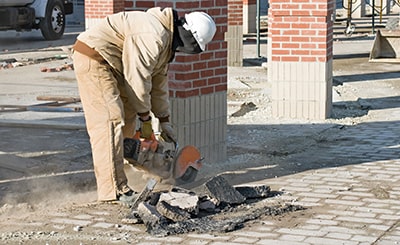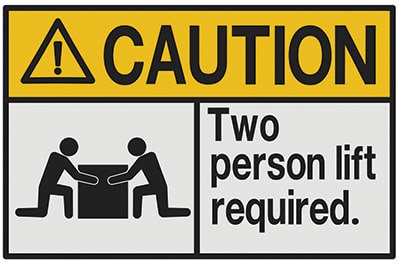Ergonomics is the second topic for National Safety Month, an annual effort to increase safety awareness created by the National Safety Council (NSC). Poor ergonomic working conditions can cause musculoskeletal disorders (MSDs). Whether you work on a construction site, on a factory floor, or behind a desk all day, uncomfortable positions, movements, and repetitive actions can cause MSDs. So, addressing ergonomic risk factors is critical to workplace safety.


Before you can address the risk, you must first understand the types of postures, movements, and actions that can cause MSDs. The Center for Disease Control (CDC) identifies a variety of ergonomic risk factors. When you evaluate jobs and tasks, look for the following factors.
Awkward Postures – Unnatural positions can be irritating in the short term and cause lasting damage over time. Awkward postures include bent, extended, or flexed positions that increase exertion and compress nerves, tendons, and blood vessels.
Contact Stress – When soft tissue comes into contact with hard objects, there is a potential for contact stress. The hard object can be external (e.g., desks or machinery) or internal (e.g., nerves, muscles, or tendons against bone). Tissue damage can occur from repeated exposure over time.
Hand-Arm Vibration – When vibration is transferred from a work process to a person’s hands and arms, it can cause tingling and numbness in the fingers, hands, and arms and can lead to painful and potentially disabling conditions.
Lifting Bulky Loads – Lifting loads over 50lb and/or of awkward size can stress the muscles, discs, and vertebrae and result in muscle pulls, back sprains, spinal injuries, elbow injuries, and wrist injuries.
Overhead Work – Tasks that require workers to raise one or both arms can result in rotator cuff tears, tendinitis, sprains, bursitis, arthritis, and neck tension. The risks of overhead work can be compounded when bending, twisting, and flexing actions are required.
Poor Shoulder/Wrist Posture – Work positions that prevent neutral shoulder and wrist alignments can cause MSDs over time. Contributing factors include high or low work surfaces and unsupported positions.
Twisting and Carrying Loads – Improper form and movement when carrying loads can result in strains, sprains, fractures, and misalignments. The back is especially susceptible to injuries from twisting and carrying loads.
Whole Body Vibration – When workers stand, sit, or recline on equipment and absorb its mechanical vibrations, it can cause back and neck injuries, neuropathy, and many other health conditions.
Wrist Deviations – Unsupported and/or repetitious wrist movements (bending, twisting, and turning) can cause MSDs, including tunnel syndromes and tendonitis. The pain and discomfort may be acute, but these conditions typically develop over time and require surgery.
The Occupational Safety and Health Administration (OSHA) encourages employers to periodically review their facilities to identify conditions that create ergonomic risk factors. To prevent MSDs, observe workplace conditions, and look for the following hazards.
Awkward Positions – Look for positions that put stress on the body, including reaching, kneeling, squatting, leaning, twisting, and bending.
Excessive Force – Look for tasks and actions that require workers to exert excessive force, including heavy lifting, pulling or pushing heavy loads, controlling tools and equipment, and manually pouring materials.
Localized Pressure – Look for tasks, positions, and actions that press a part of the body or the entire body against hard or sharp edges or using the hand as a hammer.
Repetitive Tasks – Look for tasks or actions that require workers to perform the same motions or series of movements repeatedly or frequently over an extended period.
Vibration – Look for tasks and actions that put workers in contact with machines, tools, and conveyances (e.g., lawnmowers and forklifts), transferring vibration to the body or body parts.
Cold Temperatures – Combining any of these hazards with low temperatures can increase the potential for MSDs.
Signs of Stress – Observing workers can provide the most telling cues that ergonomic risk factors may be present and MSDs may develop. Look for people modifying tools and equipment, rolling their shoulders, shaking their arms and hands, and bringing belts and braces into the workplace.

OSHA identifies the following types of controls to improve ergonomic conditions and reduce the chance of injury.
Engineering Controls – Implementing physical changes in the workplace to eliminate or reduce ergonomic risk factors. For example, modifications that eliminate and reduce awkward postures and allow a comfortable range of motion are engineering controls.
Administrative and Work Practice Controls – Establishing efficient practices and procedures and providing consistent training can prevent MSDs. For example, requiring two workers to lift and handle heavy loads can prevent spinal injuries.
Personal Protective Equipment (PPE) – Providing wearable equipment to protect workers from ergonomic risk factors can also prevent MSDs. For example, thermal gloves that allow for a full range of motion can protect workers’ hands from both cold conditions and contact stress.
These three steps were designed to help you start thinking about ergonomic risk factors in your facility. The CDC has a more in-depth process to help you identify and address hazards: Elements of Ergonomics Programs. You can also reach out to our Safety Specialists to help you improve ergonomics and prevent MSDs in your workspace. Contact us today!
